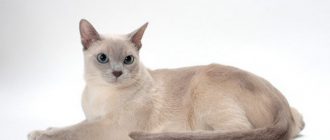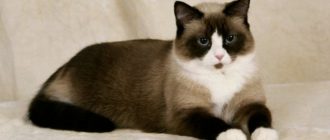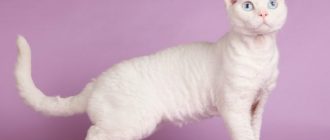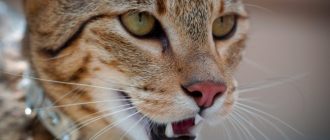Brief description of the breed
Contents
The Persian cat is considered almost the most glamorous breed in feline family. Her beautiful appearance, pretty face, slim body and calm behavior are simply stunning. They want such a cat acquire a large number of people around the world. Often persian kitty has health problems but this minus overlaps with her beauty and elegance. Persian cats are different mild facial expression, flattened face, thick coat, short and snub nose, and a massive head. In total It looks very cute. It is the Persian cat that is the most a popular breed in Russia. About the early history of this almost nothing is known to the animal. There is only the fact of their appearances in the Victorian era. Now the persian cat is divided into two types: ordinary and decorative. Decorative persian cat has a round head, small ears, flat nose, large round eyes, curly tail, and a small body (but voluminous). An ordinary Persian cat is also chubby, but its nose is longer. Both species have glamorous wool, decorated with different colors and patterns. The sweet and gentle look of a Persian cat is simply mesmerizing. A melodic voice makes us be touched by it. IN As a result of centuries-old selection, people managed to bring out the Persian a cat. In other words, we can say that humanity itself is for the perfect animal created itself. Persian is considered calm, not stupid and very affectionate animals. They become very attached to man and his family. In every possible way support in difficult minutes and having fun with their master. Perse loves to cuddle and cling to the body of the owner. Curiously considers any incomprehensible parts and objects. He will not climb curtains and cabinets as a climber, as well as rushing around the house as crazy. On the contrary, the Persian loves calm and humility. If your the family is very noisy, then the cat will need some time to adapt to it and feel comfortable. Beautiful the appearance of a Persian cat requires constant care. To her master it is necessary to constantly comb the hair and bathe in warm water. If you do it on time, you can avoid shreds of wool, wallowing around the house. Persians take a bath calmly, especially not resisting, so it’s easy for you to atone your pet.
Photo of a Persian cat:


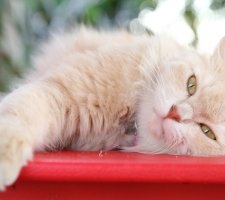
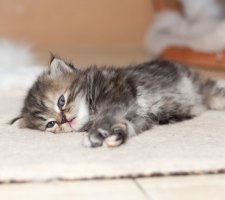
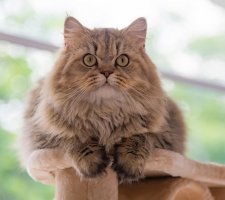
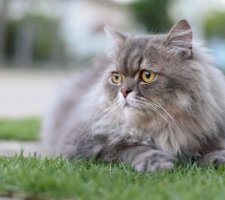
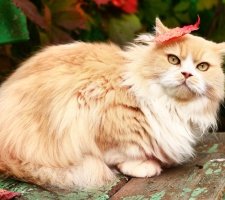
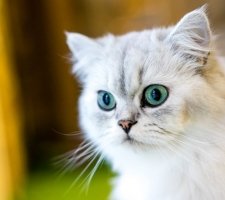
 Pictures of Dog Breeds |
Pictures of Dog Breeds |
Persian cat story
Persian Longhair cats are one of the favorite breeds breeders all over the world for over one and a half hundred years. Cats with thick silky hair appeared from Persia (hence breed name), which is now called Iran. First information about the ancestors of modern Persian cats date back to 1626, when Italian traveler Pietro della Valle visited countries The Middle East, including Persia. It was this man who brought cats in Italy, and also described them in his work “Trip to Turkey, Persia and India in 54 letters.” Those cats differed from modern Persians in their exterior – their ears were much larger, straight nose longer. Following data on long-haired cats imported from Persia belong to the 1760th. IN Georges Louis Leclerc, a naturalist and biologist, described his animal writings from France. The cats described by Leclerc were brought not only from Persia, but also from Afghanistan and Turkey. By surviving engravings XVIII century, it becomes clear that those animals did not always have wide skull, wide-set ears and short snub nose often they looked more like Angora. This gives rise to opinions that modern Persians are directly related to Turkish Angora. Interestingly, more than 2 centuries ago Persian cats were also called Russian and Asian. And if the name “Asian” is quite understandable and justified, then what kind of attitude had cats to Russia? It turns out, according to some scholars, Persian cats originally appeared in Russia, where due to severe climate acquired a dense coat, allowing animals Avoid cold weather and bad weather. Another version of the appearance of the Persian cats on Earth – crossbreeding domestic cats with manulas (wild predators with the dimensions of ordinary households that differ extremely thick and long hair, powerful body structure, squat, as in Persian cats). Breeding activity aimed at some change in appearance Persian cats began in the UK in the 19th century – face Persian cats became widest, nose upturned, ears small and widely spaced relative to each other, and eyes even wider and larger, there are many color options. At first English Persian Longhaired shows also combined with Angora cats, naming both breeds Oriental or Asian. AND only towards the end of the century – in 1887, Persian cats were officially recognized as separate from other breeds. Already from the end of the 19th century Persian cats began to appear in the USA, where over time a decision was made to slightly modernize the breed. So with time another type of Persians appeared – extreme (animals began to have shorter nose whose lobe was at the level of internal corners of the eyes). Persians for many years are the most popular among longhair cats around the world. No owners neither the difficult care of a luxurious fur coat nor the genetic predisposition to certain diseases. Cute Persian character coupled with an original appearance reminiscent of some lovers cats naive and touching children’s appearance, do not allow interest in these cats runs out. There is an interesting legend regarding these animals. As if they were born through the efforts of a wizard who created a living creature from a spark of fire, shining stars and light smoke. Who knows, maybe that’s how the world found these regal cats with chic hair and a cute face.
Persian cat character
Persians feel good about their master’s bad mood and know how to cheer him up. This species of cat family is simply not adapted to a wild independent life outside the home. Not because their hair can go bad and they can get sick. BUT because the Persians are in great need of human attention. They need constant contact with people, because they can surround the cat with affection and care. Persians are very peace-loving breeds. They perfectly fit into a large family, and become favorites of little children. They are also not prone to aggression. A Persian will never scratch or bite a child, even if he squeezes it very hard and hurts. Cat will try just run away from the baby for a while. After a while she will return to continue the fun game. Persian cats are very obedient, they will not harm property, and will be maximally neat. In fact, the Persians are quite mobile animals, just, if you compare them with other breeds, it might seem that they are very calm and passive.
Maintenance and care
Since the Persian cat is a long-haired breed, caring for It can hardly be called convenient and practical. If you want to, so that your Persian always looks beautiful and does not fade throughout the house, leaving shreds of wool in the most prominent places, please look after him. Bath procedures for a Persian cat should pass 2-3 times a week. For washing, use a special shampoo, because of the structure of the coat human shampoo will not work. On the hot summer days of Persia You can cut a little special machine. In this case, in no Do not cut the hair on the tail. Wipe regularly with a rag the eyes and nose of a Persian cat. Because because structural features of the muzzle, the breathing process is complicated for them, and the eyes constantly watering. Also do not forget to cut the claws so that the kitty looked beautiful and did not scratch various smooth objects in the House. Try to give the Persian dry and hard food more often, so that his teeth are brushed while sucking food. Only high-quality and regular care of a Persian cat will allow you enjoy their beauty. If you don’t have time to leave, trust This is a matter to your friends or acquaintances. Don’t worry this breed feline families will not show strong resistance during grooming. This is the wrong berry field.
Feeding
Persians, unfortunately, cannot boast of excellent health. Often the digestive tract fails them. So that the animal does not there were complications, the owner should avoid some products, if you plan to feed the animal with natural food. To such Prohibited products include:
- Fatty meat and poultry (pork, lamb, duck, goose);
- Bones (any – fish, chicken, beef);
- River fish (any) and oily sea (you can give very rarely);
- Fatty dairy products (especially cream, sour cream);
- Some plant foods (eggplant, peas, corn, onions, garlic, potatoes, avocado, mushrooms, nuts, persimmons, grapes);
- Flour yeast (bread, rolls and other pastries);
- Sugar, salt, pepper and any seasonings;
- Food from the table (smoked (including sausage, sausages), sweet, fatty, spicy, fried);
- Sweets (chocolate, caramel, pastry cream);
- Alcohol, soda and other drinks for cats are not intended.
The basis of natural nutrition for a cat is meat (it amounts to 60% from the daily norm of food consumed). The best options are veal, rabbit, chicken and turkey (breast), lamb (low-fat). They give meat in boiled, baked in the oven or raw form after frosts. By-products (scar, liver, lung) give the cat only boiled or raw several times a week, abuse them do not do it. Fish should not be present in a cat’s bowl more often once or twice a week (if there is urolithiasis and others kidney problems, then you should discard the fish altogether). It’s better give preference to cod, pollock, pollock, boiling and removing before feeding fluffy bones. Up to 30% of a cat’s diet consists of vegetables, they are given boiled, baked or raw. Cats are usually given carrots, cabbage (cauliflower, broccoli), zucchini (zucchini), pumpkin, beets (if there is no digestive upset), lettuce and greens (dill, parsley). 10% falls on cereals (they can be alternated with vegetables), the best option is rice, buckwheat, eggs. Required for fermented milk products – fresh, low-fat, without additives (Varenets, yogurt, kefir, cottage cheese, kittens are given milk). Can add a little vegetable oil to cat dishes. Required for purr eating natural food, vitamins (spring and in autumn), and created exclusively for cats according to age (for kittens, adults or seniors). Alternative to natural feeding – ready-made industrial cat food (dry and wet) good quality. These include extra-premium feeds and holistic. The composition of quality products cannot be less than 40% meat, while in cheap economy feeds the meat content is minimal – no more than 5% (and it is not known which meat is used, possibly offal and waste). Almost all lower feed levels contain chemical additives that are addictive in cats, and then health problems. To such potentially dangerous feeds can be attributed to known for many years (unfortunately, also popular) Kitikat, Viskas, Friskas, Darling and others. Dry and wet food for cats, provided they are of good quality can completely saturate the body of the animal with nutrients and vitamins. In addition, many owners choose this. diet due to lack of time for cooking and the inability to properly calculate the volume and composition of natural nutrition (not all cats agree to eat vegetables and cereals, for example). Vitamin Acquisition when feeding industrial products is not required – animal gets everything you need from ready-made feed.
Health and Disease
It has long been known that Persians can have hereditary diseases, and this is a big problem. Among the most popular genetic diseases of cats, it is worth highlighting: polycystic kidney disease, progressive retinal atrophy, hypertrophic cardiomyopathy, urinary stones bladder, cystitis, liver problems. To treat these diseases urgent surgical intervention is required, and these are additional money spendings. To save yourself from such financial losses, when buying a Persian, you need to study its pedigree in detail. But even with careful study, there is a risk of genetic diseases. After all, such ailments can manifest themselves after some time.

